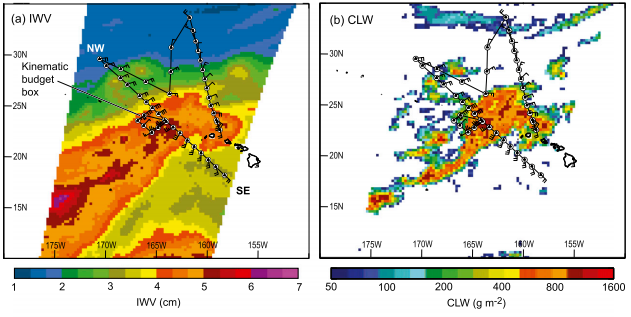HMT Publication Notice
October 24, 2014
A journal article entitled An Airborne Study of an Atmospheric River over the Subtropical Pacific during WISPAR: Dropsonde Budget-box Diagnostics, and Precipitation Impacts in Hawaii, by Paul J. Neiman, Gary A. Wick, Benjamin J. Moore, F. Martin Ralph, Ryan Spackman, and Bill Ward, was published in the September 2014 issue of Monthly Weather Review.
The Winter Storms and Pacific Atmospheric Rivers (WISPAR) experiment was carried out in January-March 2011 from the National Aeronautics and Space Administration (NASA) Dryden Flight Research Center as a demonstration for utilizing unmanned aerial systems in meteorological research and operations over data-sparse oceans. One of the campaign’s three missions was coordinated with a manned National Oceanic and Atmospheric Administration Gulfstream-IV (G-IV) flight out of Honolulu, Hawaii on 3-4 March 2011. The G-IV, which flew through a developing atmospheric river (AR) west of Hawaii, represents the cornerstone observing platform for this study and provided the southernmost dropsonde observations of an AR published to date in the subtropical northern hemisphere.
The AR exhibited characteristics comparable to those observed in previous studies farther north in the subtropics and midlatitudes, save for larger integrated water vapor and weaker winds in the AR core and stronger equatorward vapor fluxes in the shallow post-cold-frontal northeasterly flow. Eight dropsondes released in a ~200-km-wide box formation provided a novel kinematic assessment of tropospheric vorticity, divergence (mass, water vapor, sensible heat), and vertical velocity in the AR region, as well as sea-surface fluxes. The budget-box diagnostics were physically consistent with global-gridded reanalysis datasets, while also providing useful additional kinematic and thermodynamic information on the mesoscale. Meteorological impacts of the AR were assessed on Hawaii’s island of Kauai, where the state’s heaviest rainfall was observed for this case. Rainfall on Kauai was modulated significantly by its steep orography, including on the normally dry side of the island where heavy rains fell.
Contact: Paul Neiman
